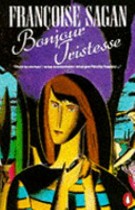 Françoise Sagan •
Françoise Sagan •
Bonjour Tristesse •
Bonjour Tristesse is so much a beach book that I always expect sand to fall from between its pages. At the time of its publication in 1954, Tristesse created an overnight sensation—partly because Sagan was only 18 when she wrote it, and partly because of its unnerving honesty. Readers who doubt the book’s emotional tenor may have forgotten the ferocity with which teenagers live.
Seventeen-year-old Cécile and her widowed father are carefree drifters, content to taste of life’s pleasures and avoid its complications. But during an idyllic summer at the Mediterranean her father shows signs of getting serious about a woman friend, and Cécile resents the intrusion. Finding that Anne has locked her in her room one hot day to make sure she studies is the last straw: Cécile determines to sabotage their romance. “This was my first contact with cruelty. I felt it grow in me, as my thoughts gave it substance. I lay stretched out, on my bed, and began to plan my revenge.”
The adults around her are no match for Cécile’s cunning, and she manipulates them like a stage manager, foreseeing every contingency but one. Her scheme unspools to its disastrous conclusion against a backdrop of sailboats and sunburns, casinos and cliffs.
Sagan became a symbol of disaffected youth in France after the book’s publication, much as J.D. Salinger’s fictional Holden Caulfield did in the United States around this same time. Although she went on to enjoy a literary career spanning five decades, Bonjour Tristesse remains Sagan’s most durable work.





Your email address will not be published.